Although kale plants are usually extremely healthy and rarely contract diseases in a home garden, sometimes they can suffer from infections.
Your best way to prevent this is to keep your plants healthy and grow them under the appropriate conditions, i.e., full sun and cool temperatures.
Covering your seedlings with floating row covers will keep out pests and keep water containing pathogens from splashing onto your kale plants.
However, there are times when your kale plants can come down with a disease. Several types of pathogens can cause the leaves of your kale plants to turn yellow and thin out.
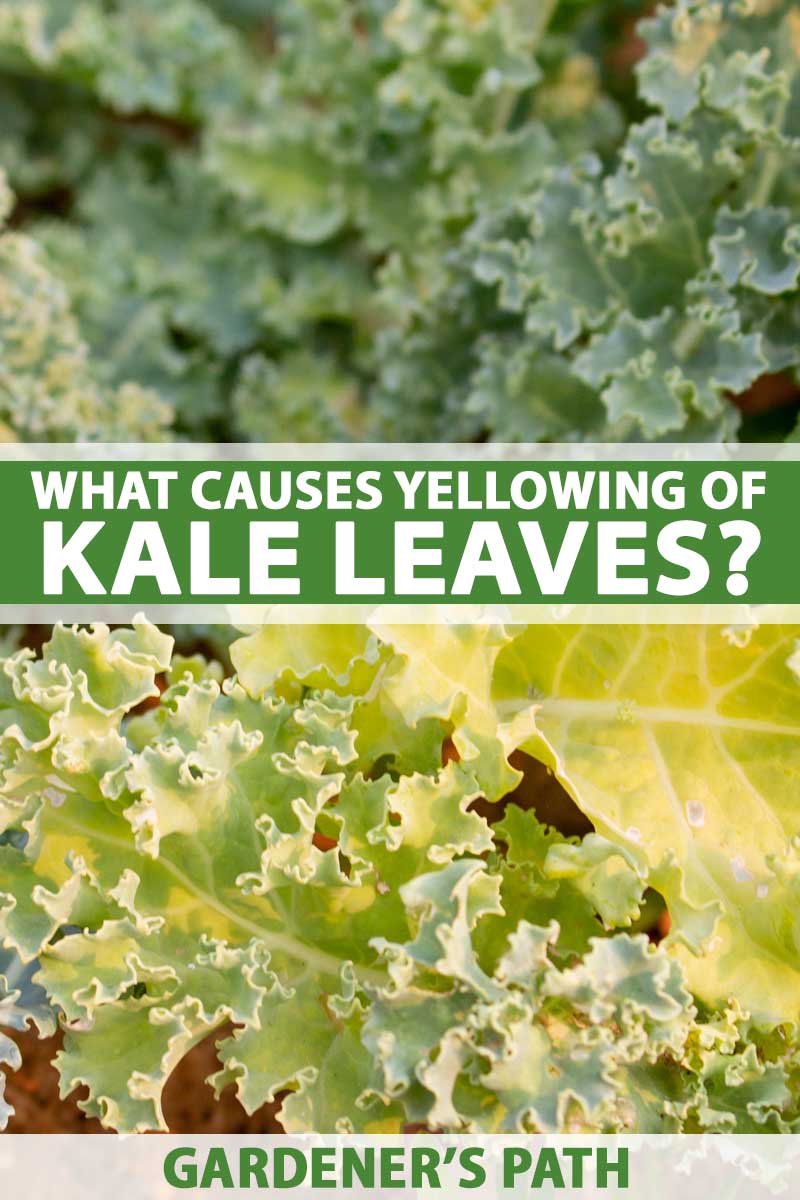
We link to vendors to help you find relevant products. If you buy from one of our links, we may earn a commission.
While factors such as nutritional deficiencies and fungal infections can produce these symptoms, yellowing leaves on kale are usually due to bacteria.
These bacterial diseases can be serious. They spread quickly and damage the leaves. Once your kale plants are infected, it may not be possible to stop the disease if conditions are favorable.
Therefore, your best bet for control is to prevent infection. Immediately remove any infected plant to try and prevent the bacteria from spreading to the rest of your crop.
In this guide we will describe these diseases and provide tips on how to prevent and manage these infections.
What You Will Learn
What Pathogens Cause Leaf Yellowing on Kale?
Several species of bacteria cause the leaves of kale to turn yellow, including two major bacterial pathogens. The two organisms are Pseudomonas syringae pv. maculicola (Psm) and Xanthomonas campestris pv. amoraciae (Xca).
The weather will affect which of these bacteria are plaguing your plants. For example, Psm prefers daytime highs of 65 F to 75 F, so it is more likely to be a problem in the Pacific Northwest or during the fall of warmer climates.
In contrast, Xca is more prevalent at warmer temperatures, so it is more likely to be a problem in the southern states.
Black rot (Xanthomonas campestris pv. campestris or Xcc) is a severe disease of kale and other crucifers, such as turnips and cabbage, although this pathogen infects kale less easily than its other cruciferous hosts.
This disease gets its name because it turns the plants black in its advanced stages. However, in its early stages, some isolates of Xcc can cause the kale leaves to turn yellow.
Initial Symptoms
Both Psm and Xca infections start out with small water-soaked lesions with halos that grow larger and merge, resulting in widespread yellowing. Severe infections can cause the leaves to die.
Death in the leaf veins is one symptom that distinguishes these bacterial leaf diseases from those caused by fungi.
Xcc usually moves into the plant’s vascular system and turns the whole plant black. However, some isolates can cause leaf blights and yellowing on kale in their early stages of infection. The leaves will drop off the plant as they die.
Black rot can be diagnosed because of the V-shaped lesions that typically occur on the edge of the leaves against the veins.
Cultural Controls to Prevent Infection
Plant Pathogen-Free Seed
Since black rot is such a severe disease, many seed companies test for its presence. The test will cross-react with the closely related Xca bacterial leaf spot, so you can buy seed that lacks both of these pathogens.
However, there are no tests for Psm, so you should try to purchase high-quality seed from companies that raise their plants in dry locations where they are less likely to contract these bacterial diseases that prefer wet conditions.
If you think that your seeds could possibly contain pathogens, you can treat them with high heat (122 F for 15 minutes).
The advantage of using hot water over bleach is that the bacteria can survive inside the seed. Bleach will only kill organisms on the surface of the seed.
We trust those companies that we recommend in our kale cultivar selection guide.
Irrigate Carefully
Since these pathogens are spread by splashing water, you should avoid irrigation with sprinklers. If you are growing your kale in a greenhouse, use ebb and flow irrigation.

Irrigate during the day. If you irrigate in the morning, there may be dew, which can help to spread these bacteria. If you irrigate too late in the day, your kale plants might stay wet overnight – another factor that makes them susceptible to infection.
Quickly Dispose of the Plant Residue
Once you have harvested your crop, you should shred and bury any diseased crop residue. Fortunately, these pathogens do not survive in the soil, so once the crop residue degrades, they will no longer be a threat.
Rotate Your Crops
It is good practice to rotate your cole crops every few years as a general practice. However, if you know you have had one of these diseases, you would be well advised to grow other types of crops on this land for two years. You could even consider four years in the case of black rot.
Control Weeds
Even if you plant disease-free seeds, that may not be enough to protect your plants if cruciferous weeds, such as wild mustard, wild radish, and shepherd’s purse, are in the area. They can all serve as reservoirs of bacteria to infect your kale plants.
Handle Seedlings with Care
If you can, plant your seeds directly where you will grow your plants. These bacterial diseases can spread much more quickly among closely spaced seedlings.

If you do grow your seedlings separately, make sure that your seedbeds are away from your main planting locations. If your seedlings are too large, do not clip them.
If you find symptoms, destroy all the seedlings around that area.
Make sure that the foliage is dry when you transplant the seedlings.
Organic Treatments
If the bacterial infection on your kale plants is not too advanced, you can try several organic methods to treat your plants.
Biofungicide
If your kale plants are in a greenhouse, you can use the organic biologically based bactericidal and fungicidal treatment Bacillus subtilis strain QST 713. It’s sold under the brand name CEASE.
CEASE™ Biological Fungicide via Arbico Organics
CEASE™ is available in much larger batches and is designed for commercial applications.
Learn more about Bacillus subtilis here.
Liquid Copper
If your kale leaves are showing signs of bacterial disease, you can also spray them with liquid copper.
BONIDE® Liquid Copper Fungicide
This treatment will not reduce the number of diseased leaves. However, it might reduce the severity of the disease.
Kale Can Contract Bacterial Diseases That Cause Yellowing
Despite its tendency to be healthy, kale plants can be susceptible to frightful bacterial pathogens under the right conditions. Once infected, their leaves will turn yellow, and the plants will be noticeably thinner.
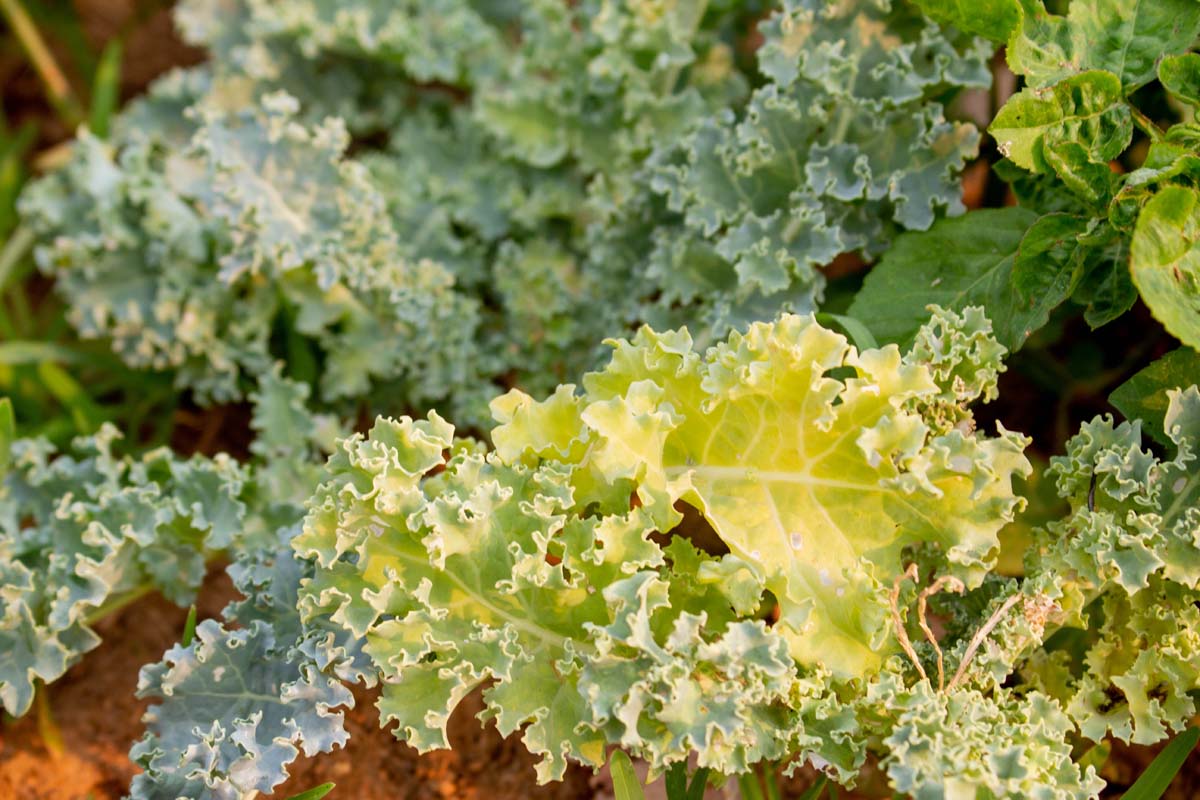
Prevention is the key to avoiding these bacterial leaf diseases. Make sure your seed is disease-free.
In addition, ruthlessly purge any wild crucifer plants in the vicinity of your kale plants, since they can serve as reservoirs of these bacteria. Weeds like wild mustard and wild radish are frequent sources of pathogens for kale and other types of crucifers.
If the disease is not too far advanced, you can treat with the biopesticide Cease or liquid copper.
Have your kale plants contracted one of these diseases? Share your experience in the comments.
Learn more about kale with these guides:
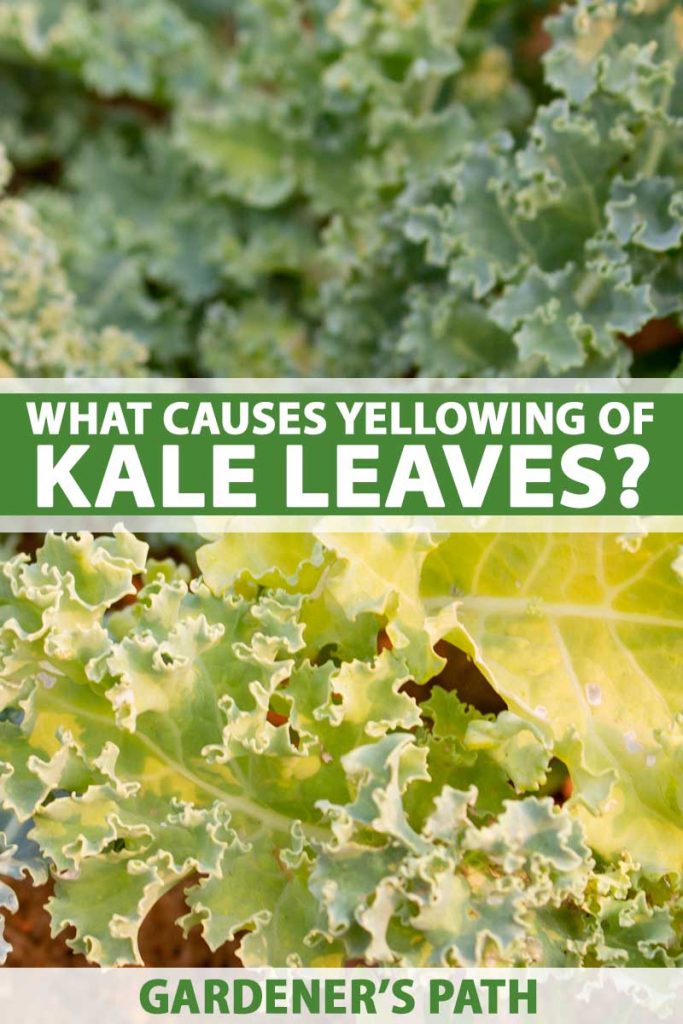
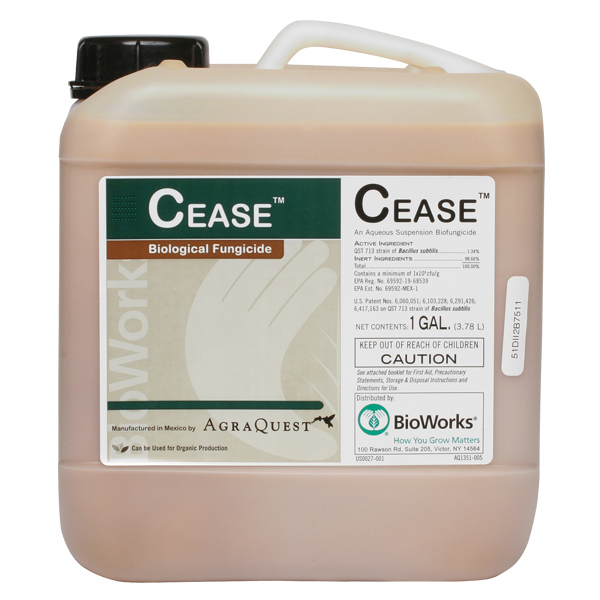
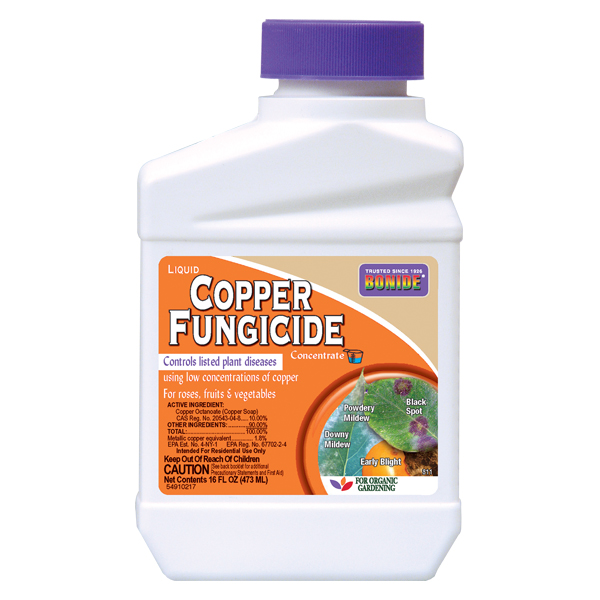
Helga, we have kale seedlings with some yellow leaves on the bottom, the center of the kale plan remains green. Do we need to treat or remove the plants?
Stephen
Hi Stephen, It’s hard to say without a picture of the leaves. Are there any spots on them, or are they just yellow? Do the leaves look normal, or are they distorted? If they are just yellow, I think it would be fine to just remove them. It’s not uncommon for the bottom leaves on plants to turn yellow.
I’m having trouble getting my kale to look healthy. They have continued to have yellowing leaves for the last 2-3 weeks and I’m not sure if they are salvageable. I may have planted them too closely as well???? I live in the PNW
Hi Angela, I’m sorry that your plants have yellow leaves. Thank you for providing a picture! There is a bacterial pathogen of kale leaves that is active in the PNW, but it would cause spots if it was the problem. I can’t tell from the pictures, but it looks like the leaves are uniformly yellow. I would remove them and destroy them to be safe, but it may not be due to a disease. I would monitor the plants closely to keep an eye out for additional symptoms, and keep us posted!
It is most helpful to know that wild mustard can cause this problem. I had some come up very near my (previously healthy) red russian kale and I kept it (the mustard) there in the hopes that its flowers would attract beneficial insects. Alas. So I’ll remove everything now and put the (sad to say) debris into the green waste can, not my compost. What can I plant in a high-heat summer in Ojai, CA, in the kale’s place with what’s left of summer’s hottest days? Or should I let the soil lay fallow for a while to destroy the… Read more »
Hi Jemi, I am so sorry to hear about the loss of your kale. You have my sympathy for gardening in Ojai. I lived in Buellton until recently, although that was easier than Tucson! I did some research, and New Zealand spinach should do well in the heat. You can get it from Burpee’s. A more exotic option is red leaf vegetable amaranth. There are several kinds of mustard greens that are supposed to be heat tolerant – Mizuna, Red Giant, and Red Splendor. I hope that one of these will grow well in your climate! Please keep us posted… Read more »
We’ve grown some kale, recently our kale leaves is turning yellow and soon turns to papery white lesions on the leaf, please see the attachments below, and could you tell us what cause it and how to do with it?
Hi Betty, I’m so sorry about your kale. Unfortunately, it looks like a bacterial infection, and they can be pretty serious. However, I can’t tell which one. Our guide to turnip and rutabaga diseases covers the three most common bacterial diseases of crucifers (including kale). If it’s black rot, there isn’t much hope. However, if it’s one of the other diseases like bacterial spot, you may be able to save your plants by spraying them with liquid copper every 7-10 days (more often if it rains). If you can’t find it locally, you can order Bonide liquid copper fungicide from… Read more »
Helga:
Thanks for sharing. I am new to hydroponics so learning trial and error. Growing Russian Kale now but a few leaves are yellow? Using fox farm organic Big grow fertilizer. used their chart for TDS and Ph and amount but realized that the chart showed more than the one listed so I called and found that I was over feeding. Could this cause yellowing?
Stephen
[email protected]
Hi everybody! I live in northern Canada, and I have that crap in my kale. No need to post a picture, it is textbook what you have shown us. I’m trying a treatment with neem oil. So far every little problem I have solved with this miracle bio product. Fingers crossed, I’m giving it a shot! If any of you gardeners have problems with doryphores, use neem oil, it does miracles.
Hi there.
I have a few questions here:
How can you identify the yellowish kale leaves is cause by bacterial infection or nutrient deficiency. Seems this symptom is occur in both situation if its happen. By the way I’m in doing an aquaponic system for curly kale and these issues happen lately.
Is there any method to make the leaves back to normal because its kind like a wasted if i need to turn over the crop as the plants already reached 58 days.
Really need your opinion on this.
Thanks.
Are the leaves yellow uniformly throughout, or suffering chlorosis with veins that remain green? Regardless of the cause, once leaves are yellow, they can’t be changed back. These should be removed and disposed of. Unfortunately it can be tough to diagnose a bacterial infection with 100% certainty without sending samples out to a lab for analysis, but you can test and regulate the nutrients that you provide to your plants, as well as the quality and quantity of the water, available light, and so on. There are ways to prevent the spread of infectious bacteria in aquaponic farming systems that… Read more »